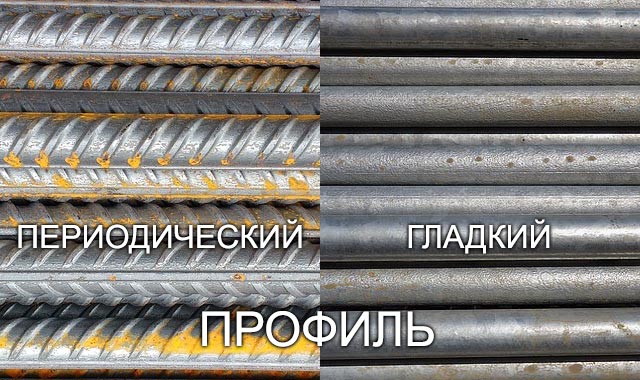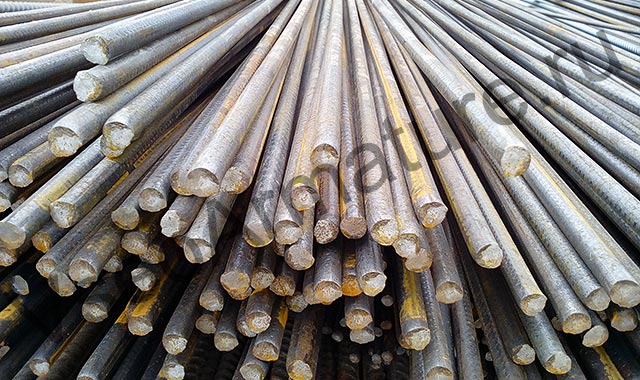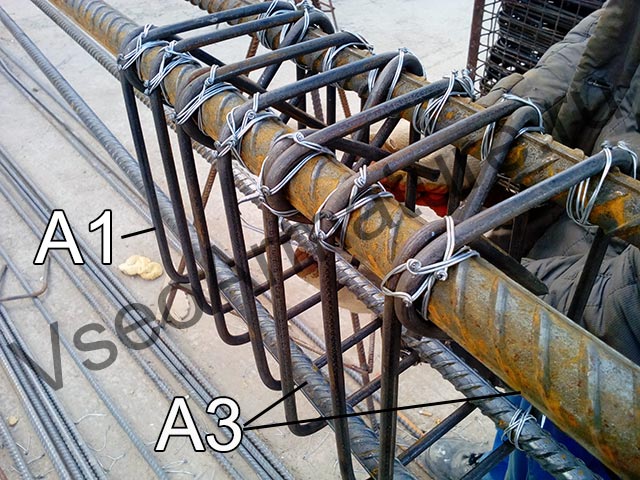When erecting reinforced concrete structures, one of the ways to ensure the greatest strength of structures with an insignificant mass of component parts is reinforcement with a steel frame. The most commonly used rods are A1 and A3. Each of the types has its own advantages and disadvantages, therefore, before buying fittings, you should familiarize yourself with the features of each individual type.
Comparison of class A1 and A3 fittings
The production is based on low-carbon steels with various degrees of deoxidation. Plastic metals with an insignificant carbon content, as well as a deep deoxidation threshold (St2kp) are usually used for A3 bars. Rigid and hard steels (St3sp) are recommended for less deformed reinforcement A1 at the time of manufacture. It is used to strengthen concrete structures, overlap any shape, release fences, gratings, etc.
Corrugated A3 reinforcement is most often used to create simple, lightweight and strong frames for various concrete structures. It is least suited for the construction of auxiliary structures, except for lightly loaded ones.
Disadvantages of A3 reinforcing rods compared to A1:
- significant internal stresses due to another rolling process (to create a groove);
- high cost due to the peculiarities of production;
- less effective cross-section of the profile, in comparison with a round bar, with the same mass of a running meter.
But the main difference between the two brands is the surface design - smooth (A1) and with grooves (A3). Naturally, reinforcement of class A3 possesses greater structural reinforcement due to better adhesion to concrete.
There are more than a dozen types of fittings on the building materials market. Despite the wide choice, in civil engineering, A1 and A3 grades are most often used. They differ both in price and in characteristics, and our article will help you figure out which material is better to choose for certain purposes.
In order to understand how the A1 reinforcement differs from A3, it is necessary to know what properties characterize this type of rolled metal.
The profile type is subdivided into smooth and periodic. The first has a flat surface, and the second has longitudinal and transverse ribs. The periodic profile adheres better to concrete, which increases the strength of the structure.

An equally important characteristic is the cross-sectional diameter. For each of the reinforcement grades, GOST establishes the permissible dimensions. With an increase in the diameter of the cross-section, both the strength of the reinforcing cage and the mass increase.
GOST also establishes the grade of steel from which the rods are made. Not only the strength of the structure depends on it, but also the corrosion resistance, which is important in aggressive environments, places with high temperature extremes and high humidity.
Based on the class of reinforcing steel and its diameter, the strength characteristics of the material are determined. In GOST 5781-82, for each brand and diameter, the yield strength, ultimate tensile strength, relative elongation and other characteristics are indicated that will allow all calculations to be made before construction.
Characteristics and features of A1 fittings
It has a smooth profile and is made of low-alloy steel (St3sp, St3ps, St3kp). The size of the produced profile can have a diameter from 6 to 40 mm. It is produced using cold rolled products. Old marking A1, new A240.

The main advantage of A1 is its high corrosion resistance. It can withstand sudden temperature changes and high humidity. Also, reinforcement with a smooth profile weld better. The disadvantages include weaker adhesion to concrete.
Features of the A1 brand:
- low price;
- less strength;
- high corrosion resistance;
- good weldability;
- weak adhesion to concrete mortar.
Characteristics and features of A3 fittings
Reinforcement A3 has a periodic profile with longitudinal and transverse stiffeners. It is made by hot rolling from steel grades 35GS, 25G2S - with a diameter of 6-40 mm, and 32G2Rps - a profile size from 6 to 22 mm. New marking A400, old A3.

The ribbed profile ensures good adhesion of the reinforcement cage to concrete. This significantly increases the strength of the supporting structure. The disadvantage is the lower corrosion resistance, which is why the A3 reinforcement is not recommended to be used in combination with some types of concrete, in places with high humidity and aggressive chemical environment.
Features of the A3 brand:
- high price;
- high strength of the reinforcing mesh;
- good adhesion to concrete;
- low corrosion resistance.
Brand selection
The A1 and A3 fittings differ not only in characteristics, but also in price. The first is about 30% cheaper than the second, so whenever possible they try to use it. The range of applications for both brands is wide, and they are often used in combination with each other.
A1 is considered a universal solution, which is considered first. It is used for the manufacture of many reinforced concrete products: slabs, rings, beams, blocks. Also, products with a smooth profile are used when pouring screed, finishing facades and for strengthening columns. It is recommended to use it for the foundation of a building as a structural and assembly one.
A3 is used in cases where increased strength is required from reinforced concrete. It is used in the construction of bridges, dams and other massive objects. Also, high-strength reinforcement is able to withstand the loads of monolithic buildings and foundations that experience high pressure. The A3 grade is also recommended to be used for the manufacture of reinforced concrete floors. In addition, it is used to strengthen the A1-based framework. The combined mesh provides high durability at an affordable price.

Joint use of reinforcement A1 and A3, when reinforcing a balcony beam.
In addition to A1 and A3 fittings, the differences of which we have already considered, enterprises also produce other brands of products that may be optimal for your task. All of them, like A3, have a periodic profile and are not so resistant to corrosion (in this regard, A1 is unique). Grade A2 is made from steel with fewer alloying additions, which makes it cheaper, but less durable. It is actively used in the construction of private houses and low-rise commercial buildings. A4, A5 and A6 are capable of withstanding huge loads, but due to the high price, their use is justified only in highly loaded structures.
It is also important in what form you will purchase products. It is produced in both rods and skeins. Let's figure out what the difference is. The limiting length of the rods is 12 meters. It is easier to work with them, since they are more convenient to cut and do not need to be straightened, but there is also a drawback. After cutting the rods, scraps inevitably remain and part of the material goes to the landfill. There is no such problem with skeins. In addition, they are indispensable when the structure requires a reinforcing mesh longer than 12 meters.
Summing up, we can say that the differences between A1 and A3 fittings make it more versatile. It is suitable in most cases and will allow you to get by with less costs, but when high strength is required, it is better not to save and use. If, after reading the article, you still have doubts about which brand of fittings to choose, then it is better to seek advice from a professional who will select the best solution for your project.
Description
What is the difference between reinforcement A1 and A3
Nowadays, a huge number of steel rods are produced for various reinforced concrete components. Steel bars or fittings A1 and fittings A3 are in high demand in construction. Which one should you give preference to? To answer this question, let us list the differences between these types of fittings: functionality; composition; appearance.
What is the difference: fittings A1 and A3
Let's take a closer look at the differences.
- Surface type... This is the most important difference between A1 and A3 fittings. This is due to the need for adhesion to concrete as a component of reinforced concrete structures. A1 has a smooth, round surface and serves as an element of reinforced concrete frames and meshes, which must be connected using electric welding. The adhesion to concrete is very weak and therefore not used in reinforced concrete structures. A3 (A400, A400C) has a corrugated surface with longitudinal ribs and transverse protrusions. They are placed along their entire length and at a specific angle. The ribs and projections provide a strong bond to concrete for the strength of reinforced concrete structures. Therefore, it is in high demand.
- Durability... Reinforced steel A3 is in great demand among builders due to its greater strength. It is used for the manufacture of products where high strength is needed, such as floors, ceilings, bridges, overpasses, etc. This is due to the material of manufacture A3: high-alloy steel with impurities of chromium, titanium, manganese, silicon. The A1 is also strong, but its strength is limited by the smooth profile characteristics.
- Versatility... In terms of its versatility, the A1 armature wins significantly. It remains reliable and does not lose its performance under extreme conditions or when exposed to various aggressive chemicals such as chlorine or natural gas. Therefore, it can be used even in the Far North at oil-producing enterprises. Steel reinforcement A3, will not withstand such conditions and will crack.
Zenina Anastasia
Sales Manager
Armature - rolled metal, which is widely used in the construction industry. At the same time, when choosing, many buyers are perplexed not only by the variety of diameters, but also by the types of rental. So, you can buy fittings with a smooth or corrugated surface. The first type belongs to class A1, the second - to class A3.
It differs not only in the type of surface, but also in the area of \u200b\u200buse, as well as other characteristics.
The main differences between class A1 and A3 fittings
The main differences between the two types of rental include:
- Application area... Smooth reinforcement has lower reinforcement characteristics than corrugated ones. For this reason, for the foundation and the manufacture of reinforced concrete structures used as a building material for facade walls, A3 class metal rolling is most often used. Also, corrugated reinforcement is used to create a road surface. The structure of the rolled product gives the structure its strength. Due to the corrugated surface, the rolled steel does not move during active operation and has better adhesion to concrete.
- Internal stress... Smooth reinforcement has less internal tension... This is due to the lack of an additional rolling process during which riffles are formed.
- Effective section... Corrugated reinforcement of class A3 with the same linear meter mass as smooth reinforcement has a smaller effective profile section.
- The cost... Due to higher production costs, the price of corrugated reinforcement is higher than that of smooth reinforcement.
- steel grade... For the production of smooth reinforcement, the harder and tougher steel grade ST3SP is most often used. For the manufacture of corrugated reinforcement, mainly low-carbon steel grades are used.
The diameter of smooth and corrugated steel is most often 8-25 millimeters. In this case, there is no difference.
In addition, if necessary, rolled metal of both classes can be subjected to additional heat treatment, which increases the operational characteristics of the reinforcement.
To improve quality welded joints during production, the reinforcement is cleaned of harmful impurities, and the technology of a more uniform carbon content is observed.
In order to increase the corrosion resistance of rolled products, a small amount of copper is added to the steel. On average, it does not exceed 2%.
When choosing between smooth and corrugated reinforcement, first of all, it is worth starting from where the rolled metal will be used. At the same time, it is important to take into account that rolled products of class A1 can be used with high efficiency to reinforce almost any reinforced concrete structures, regardless of size, shape and area of \u200b\u200btheir further use.
Also, a smooth profile is used for the production of fences, fences, floors and other auxiliary structures.
Rolled steel with corrugated surface is mainly used for foundation work, as well as for the manufacture of strong and lightweight concrete structures. This type of reinforcement is rarely used to create auxiliary structures. The exception is lightly loaded structures.
